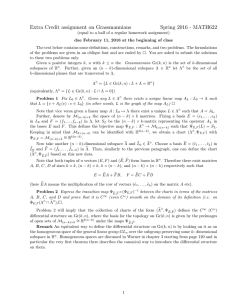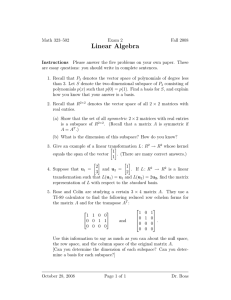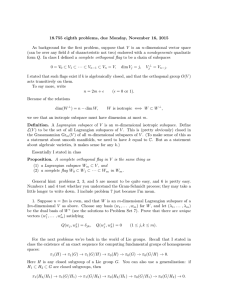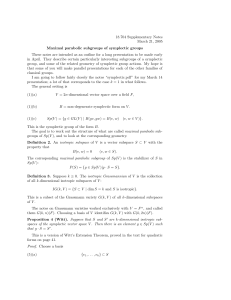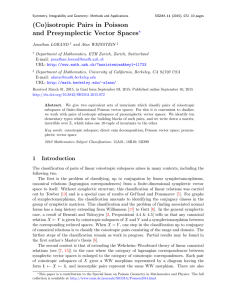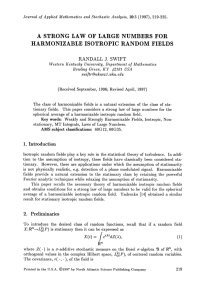18.704: Counting Points in Sp(2n, F )/Maximal Parabolic Subgroup (2n, F
advertisement
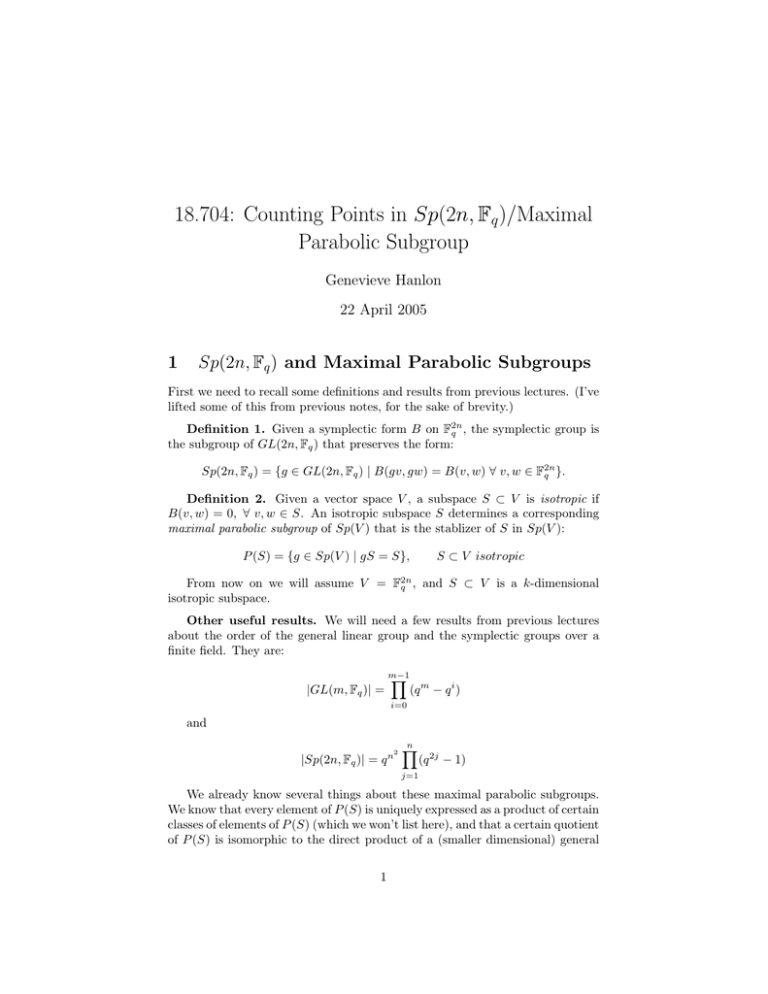
18.704: Counting Points in Sp(2n, Fq )/Maximal
Parabolic Subgroup
Genevieve Hanlon
22 April 2005
1
Sp(2n, Fq ) and Maximal Parabolic Subgroups
First we need to recall some definitions and results from previous lectures. (I’ve
lifted some of this from previous notes, for the sake of brevity.)
Definition 1. Given a symplectic form B on F2n
q , the symplectic group is
the subgroup of GL(2n, Fq ) that preserves the form:
Sp(2n, Fq ) = {g ∈ GL(2n, Fq ) | B(gv, gw) = B(v, w) ∀ v, w ∈ F2n
q }.
Definition 2. Given a vector space V , a subspace S ⊂ V is isotropic if
B(v, w) = 0, ∀ v, w ∈ S. An isotropic subspace S determines a corresponding
maximal parabolic subgroup of Sp(V ) that is the stablizer of S in Sp(V ):
P (S) = {g ∈ Sp(V ) | gS = S},
S ⊂ V isotropic
From now on we will assume V = F2n
q , and S ⊂ V is a k-dimensional
isotropic subspace.
Other useful results. We will need a few results from previous lectures
about the order of the general linear group and the symplectic groups over a
finite field. They are:
|GL(m, Fq )| =
m−1
Y
(q m − q i )
i=0
and
2
|Sp(2n, Fq )| = q n
n
Y
(q 2j − 1)
j=1
We already know several things about these maximal parabolic subgroups.
We know that every element of P (S) is uniquely expressed as a product of certain
classes of elements of P (S) (which we won’t list here), and that a certain quotient
of P (S) is isomorphic to the direct product of a (smaller dimensional) general
1
linear group and a (smaller dimensional) symplectic group. More specifically,
recall that if we choose a basis {e1 , ..., ek } of S, we can define a set of linearly
independent vectors {f1 , ..., fk } such that
B(ei , ej ) = B(fi , fj ) = 0,
B(ei , fj ) = δij
(1 ≤ i, j ≤ k)
where δij is the Kronecker delta. Thus {f1 , .., fk } is a basis for a k-dimensional
isotropic subspace T ⊂ V, T 6= S. If we define
W = (S ⊕ T )⊥ = {w ∈ V | B(w, ei ) = B(w, fi ) = 0, (1 ≤ i ≤ k)},
then W is a 2(n−k)-dimensional subspace of V, and V = F2n
q = (S ⊕T )⊕W .
During a previous lecture, it was shown that there exists a normal subgroup N
of P (S) consisting of symplectic transformations, each uniquely determined by
a k × k symmetric matrix over V and a linear map A : T → W :
N = {NA ZE | A ∈ Hom(T, W ), E a (k × k) symmetric matrix}
.
The details of NA and ZE are rather hairy, so we omit them here (they can
be found in previous notes). The important thing is that each element of N
is uniquely determined by our choice of A and E, and that N is our normal
subgroup such that
P (S)/N ∼
= GL(k, Fq ) × Sp(W )
.
So now we have enough information to determine the order of P (S). First
we must determine the order of the subgroup N : since every element of N is
uniquely determined by our choice of A and E, we simply have to count how
many such choices we can make. Since our generic A is simply a linear map from
a k-dimensional subspace to a 2(n − k)-dimensional subspace, A is determined
by its associated (k × 2(n − k)) matrix with entries in Fq . There are q 2k(n−k)
such matrices, and thus q 2k(n−k) choices for A. (Recall that A is not required to
be invertible.) For our choice of (k × k) symmetric matrix E, we note that we
can construct a basis for the (additive) group of all (k × k) symmetric matrices
from the elementary matrices. In particular, the matrices of the form
eii
or
(eij + eji ),
(1 ≤ i < j ≤ k)
= k(k+1)
-dimensional basis B for the (k × k) symmetric
form a k + k(k−1)
2
2
k(k+1)
matrices. Let m =
,
and
relabel the basis elements of B as {v1 , ..., vm }.
2
Then every expression of the form
E = c1 v1 + ... + cm vm
2
ci ∈ Fq
yields a unique (k × k) symmetric matrix, and so there are q m such matrices.
Combining our results, we see that there are q m q 2k(n−k) choices of A and E,
and thus
|N | = q
k(k+1)
2
q 2k(n−k) = q (
k(k+1)
)+(2k(n−k))
2
.
Since we know that P (S)/N ∼
= GL(k, Fq ) × Sp(W ), and we know how to
compute the cardinality of both GL(k, Fq ) and Sp(W ) (remembering that W is
a 2(n − k)-dimensional space), we can compute the cardinality of P (S):
|P (S)| = |N | · |GL(k, Fq )| · |Sp(W )|
= q(
k(k+1)
)+(2k(n−k))
2
·
(1)
k−1
Y
2
(q k − q i ) · q (n−k) ·
=q
k(k+1)
)
2
·
k−1
Y
k
(q 2j − 1)
(2)
j=1
i=0
(n2 −k2 )+
n−k
Y
i
(q − q ) ·
n−k
Y
(q 2j − 1).
(3)
j=1
i=0
(4)
Now we can finally count the points in Sp(2n, Fq )/P (S). For convenience,
let M = |Sp(2n, Fq )/P (S)|. Then we have
M=
|Sp(2n, Fq )|
|P (S)|
(5)
Qn
2
q n · l=1 (q 2l − 1)
Qk−1
Qn−k
k(k+1)
2
2
q n −k + 2 · i=0 (q k − q i ) · j=1 (q 2j − 1)
Qn
(q 2l − 1)
= −k(k−1) Qk−1 l=1
Qn−k
q 2
· i=0 (q k − q i ) · j=1 (q 2j − 1)
=
(6)
(7)
Note that
k−1
Y
(q k − q i ) = q
k(k−1)
2
·
k−1
Y
(q i − 1).
i=1
i=0
So we can cancel out the powers of q in the denominator, obtaining
Qn
2l
l=1 (q − 1)
M = Qk−1
.
Q
n−k 2j
i
− 1)
i=1 (q − 1) ·
j=1 (q
Qn−k
Qn
Since j=1 (q 2j − 1) clearly divides l=1 (q 2l − 1), we can cancel further,
obtaining
M=
(q 2n − 1)(q 2n−2 − 1)...(q 2(n−k)+2 − 1)
(q k−1 − 1)(q k−2 − 1)...(q − 1)
3
.
But we can simplify even further. If we divide both numerator and denominator by (q − 1), we see immediately that the denominator is
Qk−1
(q i − 1)
= [k]q !.
q−1
i=1
The numerator is less obvious, but still (thankfully) manageable. Since every
term of the numerator is the difference of two squares, we can factor it:
(q
2n
− 1)(q
2n−2
− 1)...(q
2(n−k+1)
− 1) =
n
Y
n
Y
i
(q − 1) ·
(q j + 1)
j=n−k+1
i=n−k+1
and since we still need to divide the numerator by (q − 1), we find that
Qn
i
[n]q !
i=n−k+1 (q − 1)
=
,
(q − 1)
[n − k]q !
which is nice, because now we have
|Sp(2n, Fq )|
|P (S)|
[n]q !(q n + 1)(q n−1 + 1)...(q n−k+1 + 1)
=
[k]q ![n − k]q !
M=
(8)
(9)
.
So given a k-dimensional isotropic subspace S ⊂ F2n
q , we now know that
[n]q !
|Sp(2n, Fq )/P (S)| =
·
[k]q ![n − k]q !
2
n
Y
(q i + 1).
i=(n−k+1)
What Does This Actually Mean?
So far we’ve counted points in Sp(2n, Fq )/P (S), but it’s not entirely clear what
these points represent. In fact, the construction Sp(2n, Fq )/P (S) is itself a little
weird - since the stabilizer isn’t necessarily a normal subgroup, this is not really
a valid group decomposition, so we can really only concern ourselves with the
underlying set and group action. Still, we have divided out by the stabilizer
of subspace, and that should mean something. A version of Witt’s Extension
Theorem introduced in class can help:
Theorem 1. Suppose S and S ′ are k-dimensional isotropic subspaces of
a symplectic vector space V . Then there is an element g ∈ Sp(V ) such that
gS = S ′ .
From this we can conclude that the orbit of S under the action of Sp(V )
contains all isotropic k-dimensional subspaces of V . In fact, if we go back to
4
the definition of the symplectic group Sp(V ) and the definition of an isotropic
subspace,
Sp(V ) = {g ∈ GL(V ) | B(gv, gw) = B(v, w) ∀ v, w ∈ V }
S ⊂ V isotropic ⇐⇒ B(v, w) = 0 ∀ v, w ∈ S
we see that no element g ∈ Sp(V ) can carry an isotropic subspace S ⊂ V to
a non-isotropic space, i.e., for symplectic form B and g ∈ Sp(V ), if S isotropic,
then B(v, w) = 0 ∀ v, w ∈ S, and since g ∈ Sp(V ), B(gv, gw) = B(v, w) =
0 ∀ gv, gw ∈ gS = S ′ . Thus the image of S under the action of g, S ′ , is also
isotropic. Clearly S and S ′ will have the same dimension. So the set of kdimensional isotropic subspaces forms a single orbit under the action of Sp(V ).
From elementary group theory we have the familiar orbit-stabilizer theorem:
Theorem 2. Suppose the group G acts on the set X, and let
Gx = stablizer of x in G = {g ∈ G | gx = x}
Ox = orbit of x under G = {y ∈ X | gx = yf orsomeg ∈ G}
Then |G| = |Gx ||Ox |
∀ x ∈ X.
So our ”points” in Sp(2n, Fq )/P (S) actually represent all the k-dimensional
isotropic subspaces of F2n
q . In other words, we’ve found the cardinality of the
isotropic Grassmanian IG(k, F2n
q ):
Qn
[n]q ! · i=n−k+1 (q i + 1)
2n
.
|IG(k, Fq )| =
[k]q ![n − k]q !
5
